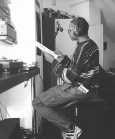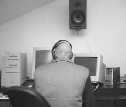Intercity Radiothon
'Compulsive' is a word often used to describe our relationships with computers. Combine the compulsiveness of the computer drug with the hypnotic effects of voices on radio and you've got Torkradio. Frustrated by their experience of making 30 second 'audio blipverts' for a local radio station, Chris Dorley Brown and Bob Jarok of Cambridge's music and arts venue The Junction decided to make something more "marathon like" - an extended 72 hour audio experiment involving over 20 visual and performance artists. The Net offered the perfect environment for an audio project breaking with the conventions of radio's time compression, musical etiquette and high production values.  Tim Read, of UK web radio station Gaia Live and 'facilitator' of Torkradio, described the technical 'amateurism' of many of the artists as giving the whole event an open-ended, "sky's-the-limit feel". Although many artists had a background in performance (amongst others the writer Anne Whitehurst, the theatre group Desperate Optimists, the performance artists Alan Howley and Roney Fraser Munro, and Sony Radio Music Award winner and artist Chris Cheek), digital audio editing and webcasting tended to provide a new challenge. Czech artist Pavel Buchler described Torkradio as a 'laboratory atmosphere' in which there was no pressure for ideas to succeed. With limited knowledge of where technical boundaries lay, these boundaries could be happily (because unwittingly) overstepped. Dorley Brown explained how the strange paradox of being globally accessible and by the same token virtually invisible shifted the focus away from a concentration on listeners to the mad, sleep-deprived dynamics of the studio itself.
Tim Read, of UK web radio station Gaia Live and 'facilitator' of Torkradio, described the technical 'amateurism' of many of the artists as giving the whole event an open-ended, "sky's-the-limit feel". Although many artists had a background in performance (amongst others the writer Anne Whitehurst, the theatre group Desperate Optimists, the performance artists Alan Howley and Roney Fraser Munro, and Sony Radio Music Award winner and artist Chris Cheek), digital audio editing and webcasting tended to provide a new challenge. Czech artist Pavel Buchler described Torkradio as a 'laboratory atmosphere' in which there was no pressure for ideas to succeed. With limited knowledge of where technical boundaries lay, these boundaries could be happily (because unwittingly) overstepped. Dorley Brown explained how the strange paradox of being globally accessible and by the same token virtually invisible shifted the focus away from a concentration on listeners to the mad, sleep-deprived dynamics of the studio itself. Venturing beyond its caffeinated confines, some of the participants incorporated local interviews and recordings into the mix. One of the most memorable was Chris Cheek's piece in which he approached locals with a microphone and innocently enquired: "Could you tell me where the heart of Cambridge is?" Mostly, the respondents saw nothing unusual in his phraseology and duly trotted out directions. Stewart Home also incorporated the live prankster element into his slot when he rang local prostitutes and asked whether they were prepared to perform variously depraved sexual acts in unusual locations. When they replied in the affirmative he would earnestly explain that he had a pass to the reactor of a nuclear power station or other such end-game scenarios. The handset was swiftly replaced. Whilst Alan Howley read out melancholic love stories involving his mother and father, knitting enough archetypes together to undo even the most hardened psychoanalyst, the heavy base from The Junction's downstairs club pulsed audibly.
Venturing beyond its caffeinated confines, some of the participants incorporated local interviews and recordings into the mix. One of the most memorable was Chris Cheek's piece in which he approached locals with a microphone and innocently enquired: "Could you tell me where the heart of Cambridge is?" Mostly, the respondents saw nothing unusual in his phraseology and duly trotted out directions. Stewart Home also incorporated the live prankster element into his slot when he rang local prostitutes and asked whether they were prepared to perform variously depraved sexual acts in unusual locations. When they replied in the affirmative he would earnestly explain that he had a pass to the reactor of a nuclear power station or other such end-game scenarios. The handset was swiftly replaced. Whilst Alan Howley read out melancholic love stories involving his mother and father, knitting enough archetypes together to undo even the most hardened psychoanalyst, the heavy base from The Junction's downstairs club pulsed audibly.  Appropriation and sound collage were favoured tropes. Pavel Buchler's piece 'Pavel Buchler's Finest Hour' excised the audience applause and stage comments from three live recordings of Rolling Stones, Billie Holliday and Louis Armstrong hits to synthesise one 'greatest hit'. Thousands of voices were compressed into each minute of sound. Although very often the concept behind such pieces was lost in the execution, resulting in undifferentiated 'noise' which made the works hard to tell apart, as Read puts it, "the God is in the detail". Extending the audio blipverts into a sound continuum, and inverting the logic of the small intervention in mainstream media, Torkradio spreads itself across the vast indifference of the Net. In the locale of frenetic data exchange and cacaphonic chat, brief moments of coherent detail provide small rafts with which to negotiate the endless expanse. As the paternal days of the solo DJ voice give way to the 'noise' of synchronous chat we come closer to the proverbial life-sized map disintegrating and mixing with the ground it covers. Torkradio puts a whole new spin on the concept of the 'attention economy'.
Appropriation and sound collage were favoured tropes. Pavel Buchler's piece 'Pavel Buchler's Finest Hour' excised the audience applause and stage comments from three live recordings of Rolling Stones, Billie Holliday and Louis Armstrong hits to synthesise one 'greatest hit'. Thousands of voices were compressed into each minute of sound. Although very often the concept behind such pieces was lost in the execution, resulting in undifferentiated 'noise' which made the works hard to tell apart, as Read puts it, "the God is in the detail". Extending the audio blipverts into a sound continuum, and inverting the logic of the small intervention in mainstream media, Torkradio spreads itself across the vast indifference of the Net. In the locale of frenetic data exchange and cacaphonic chat, brief moments of coherent detail provide small rafts with which to negotiate the endless expanse. As the paternal days of the solo DJ voice give way to the 'noise' of synchronous chat we come closer to the proverbial life-sized map disintegrating and mixing with the ground it covers. Torkradio puts a whole new spin on the concept of the 'attention economy'.
Josephine Berry Xjosie AT metamute.comX
Mute Books Orders
For Mute Books distribution contact Anagram Books
contact@anagrambooks.com
For online purchases visit anagrambooks.com







